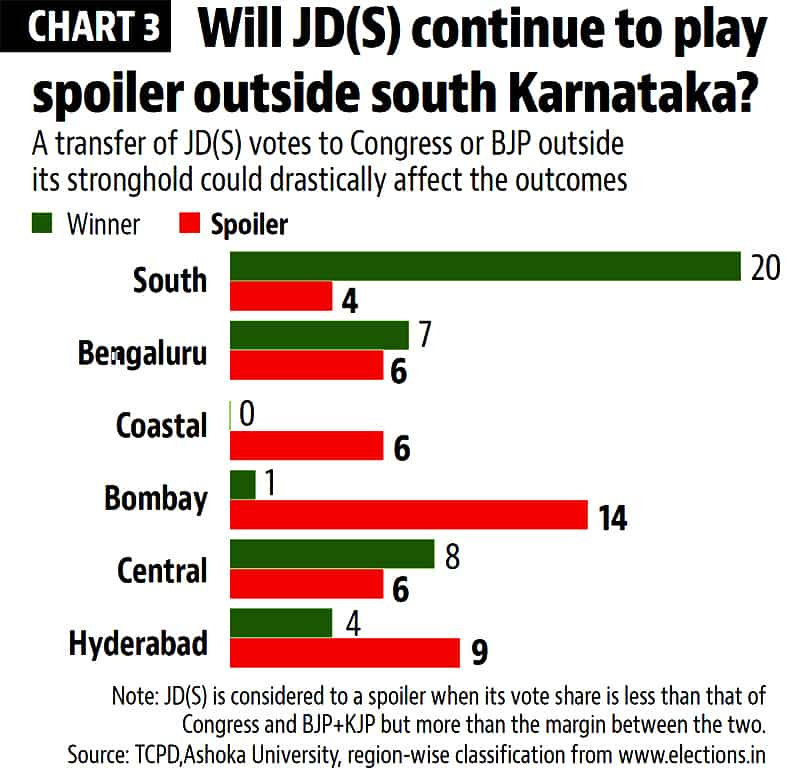Karnataka elections: JD(S) is effective in leveraging networks across the state
Of the 40 seats JD(S) won in 2013, 20 were from outside South Karnataka — where the JD(S) has been effective in leveraging local patronage networks to win non-Vokkaliga votes.
“Deve Gowda is everything to us,” explains an elderly man in a village near a lake in Channarayapattana taluk dominated by the Vokkaliga (Gowda) community. HD Deve Gowda, the leader of the powerful Vokkaliga community in Karnataka, is the founder of the Janata Dal (Secular) [JD(S)]. So strong is his hold in South Karnataka (and that of his son, HD Kumaraswamy) that voters have nary an opinion on demonetisation, Prime Minister Narendra Modi, or much of anything else.

But it would be wrong to say that JD(S) only does well in South Karnataka (where the Vokkaliga are numerous). Of the 40 seats JD(S) won in 2013, 20 were from outside South Karnataka — where the JD(S) has been effective in leveraging local patronage networks to win non-Vokkaliga votes.
Read: Karnataka elections 2018: Polling underway in 222 constituencies, 10.6% voter turnout till 9 am
Congress chief minister Siddaramaiah is well aware that if he is to return to power, he will have to significantly eat into the non-Vokkaliga votes of JD(S). Congress politician Devaraj Urs, the last chief minister to secure re-election (in 1978), famously constructed the AHINDA (a Kannada acronym for minorities, backward classes and Dalits) coalition to win the election. Siddaramaiah is trying to reconstruct this coalition of disparate groups by pointing to a number of popular welfare schemes he created.
To understand the impact JD(S) has on the electoral system, we characterised the number of seats won by JD(S) and the number of seats in which JD(S) plays “spoiler” by region. We defined JD(S) as a spoiler when it finished third or lower, as compared to Congress and the combined vote share of BJP and KJP (since BS Yeddyurappa has returned to the party), but has greater vote share than the margin between Congress and a combined BJP/KJP.
Watch video: Free dosa at this Bengaluru cafe for first timers who vote today
In effect, these are seats in which JD(S) had no chance of winning but had enough votes to push the second place party over the top. While in the south, JD(S) wins many seats and is spoiler in very few, the situation is reversed outside the south — where JD(S) won 20 seats but played spoiler in 41.. This implies that there are a large reservoir of votes that the AHINDA strategy can plausibly bring into the Congress fold from JD(S) to stave off a stronger BJP than 2013.

Indeed, we’ve found evidence that it is working. If one of the three components of Siddaramaiah’s AHINDA strategy is likely to band together unanimously, it is the Muslim vote. There is perceived bonhomie between JD(S) and BJP this time and this is acutely understood by the Muslim population across regions. Campaigning by the likes of UP CM Yogi Adityanath has helped consolidate the Muslim vote towards Congress. “We must ensure at all costs that our Karnataka does not become like UP — where such communalism is common,” explained a Muslim rice trader in Honnali town of Davangere district.
Read: Karnataka elections: JD(S) is effective in leveraging networks across the state
Compared to the Muslim question, Dalit voting presents a much more fractured picture. In a village in Haveri district, a middle-aged Dalit farmer told us that although he appreciated many of Siddaramaiah’s welfare schemes he was worried about local power structures. “Siddaramaiah is a Kuruba leader, and can be very partial to Kurubas. Since there are many Kurubas in the village, if BJP wins here we might be able to reduce their influence.” To add to the complication, there is enmity with another nearby Dalit community.
“They (the other Dalit community) think that we have come up through reservations at their expense. If they feel that we are going to vote for the BJP, they would definitely vote for the Congress,” he said.
By contrast, both young and middle-aged Dalit voters in Bhadravati said they would be firmly behind Congress. “The JD(S) is a party of Gowdas, and Siddaramaiah is not a casteist leader. Under him, Muslims, Dalits and a few of the backward class communities have had peace and good relations.” In this election, Congress needs to win over non-Vokkaliga voters from the JD(S) to score a big victory. An effective AHINDA consolidation is exactly what will guarantee such an outcome.
(Neelanjan Sircar is a senior fellow, Centre for Policy Research. Pranav Kuttaiah is a research assistant at the Centre for Policy Research)



